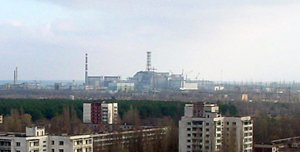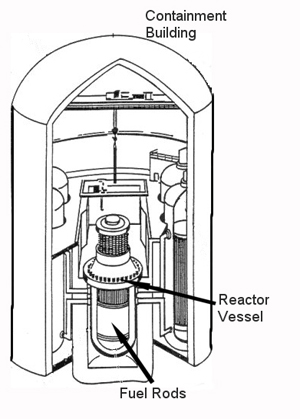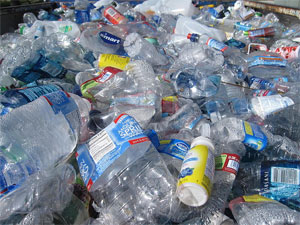Today, nuclear power plants are one of the most common forms of power production. Much of the world today is dependent on nuclear power, despite the inherent danger that radioactive fuel presents. Although nuclear power plants have been engineered for the utmost safety during normal operation, they are still vulnerable to intentional acts of sabotage. For example, a large passenger jet could crash into a nuclear power plant. Because of the amount of fuel present in some jets, the explosion following the crash would almost inevitably lead to a meltdown, exposing millions of people to dangerous radiation. Even though the US government has found diagrams of US nuclear power plants in Afghanistan, which would suggest the possibility of a planned attack, these nuclear reactors have not been strengthened to withstand a great impact or survive such an explosion. A disaster caused by such a plane crash would likely be much worse than Chernobyl; therefore, it is imperative that engineers design new and improved methods of protecting nuclear power plants from an attack that could cause the widespread release of radiation.
Introduction
Ever since the middle of the 20th Century, nuclear power plants have been one of the world’s leading sources of power, creating energy by a means that was once thought to be impossible. There are currently 104 nuclear power plants in more than 25 states across the United States that combine to create over 20% of the nation’s power. A single nuclear power plant with two reactors working at full capacity can create enough electricity to power over two million homes. This form of generating power has been commended for its emission-free results, and countries all over the world are dependent on nuclear power to illuminate their homes and workplaces. Still, nuclear power has been criticized for its inefficiency, and most importantly in the United States, the security risk it poses to anyone living even remotely near to one of these plants.
Nuclear power plants are among mankind’s most amazing creations, even in light of the problems they may cause. These plants have been engineered to create immense amounts of electricity while still keeping safety a top priority. Since these plants are almost always operating safely and reliably, the main concern of the new millennium is not with the efficacy of such plants, but rather with the possibility of sabotage from external forces. Specifically, a terrorist attack on a nuclear power plant could drastically affect the lives of the citizens living near the plants. Each of the plants contains several hundred thousand tons of radioactive nuclear fuel that, if released, could affect all forms of life within a 100-mile radius. Recall the nuclear disaster at Chernobyl nearly 16 years ago (see Fig. 1), which was due to human error and killed over 4000 people, many of whom lived in close proximity to the plant. One can only imagine the amount of human life at risk if one of these power plants was intentionally sabotaged–which seems possible given the attack on the World Trade Center. Power plants help create electricity that allows us to live our day-to-day lives, but we have to consider and attempt to prevent the possibility that one of these complex engineering wonders could be used as a weapon against us.
The Design of Nuclear Power Plants
Because of the danger posed by the effects of radiation, nuclear power plants have been engineered to maintain containment of the radioactive materials even in the result of a major disaster. However, even though these buildings have complex safety and shutdown procedures, the human element that monitors and controls these machines is crucial–as was proved with the disaster at Chernobyl. Nuclear power plants span thousands of square feet. The nuclear reactor, which actually generates the power, is the heart of the plant. The reactor itself is surrounded by a huge containment system, which is designed to trap the radioactive fuel in the event of a leak or other malfunction. The outside of the containment structure is a concrete wall, which, depending on the design, is around 2-4 feet thick. The inside of the containment structure is highly complex; it consists of high-pressure pipes which both prevent the leak of radioactive fuel and cool down the fuel in the event that the reactor has to be shutdown. The figure below shows the construction of the reactor core with the containment around it and the high-pressure pipes going in and out of the containment structure (Fig. 2).
Surrounding the reactor and containment structures are several other buildings vital to the operation of the plant. The switchgear building is located very close to the reactor and contains the control room and all of the electrical workings of the plant. There is also the emergency power building, which can control the plant if the switchgear building is unavailable. Finally, there are the cooling towers, which work to cool the radioactive fuel if the reactor has to be shutdown [1]. These three buildings are essential to the plant for normal operation and critical in the event of a disaster. The figure below shows the design and layout of the buildings in a typical nuclear power plant. All the buildings in these plants were engineered using the “two group” concept, which means that there are two groups of systems, whereby each group can shutdown the reactor, minimize the leak of radioactivity, and monitor the status of plant. The purpose of this “two group” concept is to allow the manipulation of the safety procedures in the plant even if one group has been disabled or is unavailable [2]. While this containment structure and “two group” concept make it seem highly unlikely that a radioactive leak would occur, the protocol was designed to counter problems that would arise from standard operation or slight human error; therefore, it would have minimal effectiveness if the plant were intentionally sabotaged.
The Threat to Nuclear Power Plants
Considering the attack on the World Trade Center, the possibility of an attack on one of our power plants seems possible. The fact that terrorists were able to take over our planes and carefully maneuver these planes to attack buildings only proves that today’s terrorists are much more advanced and motivated to cause mass destruction. If terrorists are capable of crashing a plane into a large high rise building, they could just as easily crash into a nuclear power plant.
Although many of the reactors in nuclear power plants can sustain a crash from a small, slow moving aircraft, only four of the 104 nuclear power plants functioning in the US today were engineered to resist a commercial plane crash, because all four are located near airports. Regardless, these four plants would not be able to withstand a massive 747 filled with fuel, like the ones that hit the World Trade Center [3]. A 747 could no doubt penetrate the concrete housing that protects the reactor. Even David Kyd, a spokesperson for the International Atomic Energy Agency, said that nuclear reactors are “built to withstand impacts, but not that of a wide-bodied passenger jet full of fuel” [4]. A Department of Energy study in 1982 found that even if 1% of a 747’s fuel ignited inside the reactor, the explosion would be equivalent to 1000 lbs. of dynamite [4]. This further proves that not only could a passenger jet penetrate the reactor of a nuclear power plant, but that the explosion following the crash could cause the leakage of massive amounts of radioactive fuel. Since history has proven it possible that terrorists can conceivably crash a passenger jet into a power plant, we need to consider the effects of such a disaster and what can be done to prevent it.
Can the Nuclear Power Plants be Protected?
Although nuclear power is an engineering marvel, it does have its negative side effects and weaknesses that allow it to be a danger and thus a target for negative criticism. Recently, the people most critical of nuclear power have been those who live near a plant. One of the greatest weaknesses of nuclear power has always been the issue of what to do with the spent fuel [5]. The fuel pools, which are often near the reactor, contain about five times more radioactive fuel than the reactor itself [4]. This means that if a plane were to crash into a nuclear power plant, heavy amounts of radioactive fuel would be released if either the fuel storage building or the reactor building were penetrated. However, if only one of the safety or control buildings was hit, chances are high that it would not lead to meltdown. On the other hand, if the plane was full of fuel, a large explosion would follow the crash. And since the nuclear power plants were not meant to deal with severe fires [4], if a passenger jet filled with fuel crashed into a nuclear power plant, a meltdown would likely occur. Furthermore, if high amounts of radioactivity were released from a nuclear power plant, an area of about 100,000 square miles would be contaminated. A case for which this is extremely critical is the Indian Point power plant, which is located only 33 miles from Times Square. For any nuclear disaster, the Nuclear Regulatory Commission (NRC) defines the “peak-injury zone” as anything within a 50-mile radius of the disaster, which for Indian Point means that there are 20 million people living in this zone if a disaster were to occur at Indian Point [6]. This fact has many New Yorkers uneasy about the plant. Also, it is interesting to note that the spent fuel buildings at Indian Point have only 5-8 inch concrete walls, while the walls of the reactor buildings are solid concrete and 3 1/2 feet thick. This is extremely alarming; especially considering an NRC report that concluded that half of the jumbo jets flying today could easily break through a five foot thick concrete wall [5]. Given the possibility of a terrorist attack and the consequences that could result, the crucial problem that engineers must address is how to prevent such a disaster.
Since the events of September 11, 2001, there have been several measures to increase security at nuclear power plants. However, none of these measures would prevent the disaster that would result from an aerial attack. First of all, the NRC has advised governors of states with nuclear power plants that they may call upon the National Guard if additional security of these plants is required [7]. Also, nuclear plants that are near large bodies of water have had the coast guard regularly patrol the waters so as to prevent an attack from sea. Recently, Senator Edward Markey (D) of Massachusetts has sponsored a bill that would allow federal control of security for all nuclear power plants. While all of these acts are well and good for the safety of these plants, they do nothing in terms of preventing a disaster that could occur from an aerial attack, such as from a plane.
Since the attacks on the World Trade Center, neither changes to the structure of reactors nor the structure of spent fuel buildings have been implemented. Such changes would require not only large amounts of testing, but approval from many groups of people involved in the nuclear industry. Despite this, on October 16, 2001, NRC Chairman Richard Meserve, in a letter to Senator Edward Markey, said that the NRC is currently engaged in an advanced engineering analysis that would determine the effects of a crash from a large airliner on a nuclear reactor considering such variables as speed, size, and amount of fuel [8]. The NRC has also rejected a plan to equip nuclear power plants with anti-aircraft devices that would shoot down any aircraft coming too close to the reactor not only for fear of the possibility of shooting down innocent planes, but also because locating missiles too close to the reactor is dangerous [9].
Conclusion
It is clearly evident that our nuclear power plants are vulnerable to terrorist attacks. Moreover, it is possible that a large airliner could penetrate a nuclear power plant, or spent fuel structure, which would cause a release of radioactive fuel. Considering the attacks on the World Trade Center and President George W. Bush’s State of the Union Address in which he made the public aware that diagrams of US nuclear power plants were found by US troops in Afghanistan, it is fairly obvious that terrorists have not only the means but the motivation to crash such an airliner into a nuclear power plant. Given this information, these nuclear reactors must be fortified to sustain the impact of a large jet because of the amount of human life that is at stake. By reflecting back on the disaster at Chernobyl and the many lives that were affected by the accident, it is apparent that the NRC should hire engineers to develop a solution that protects nuclear reactors and consequently anyone living near a nuclear power plant from a possible attack and the potential damage that would result.




